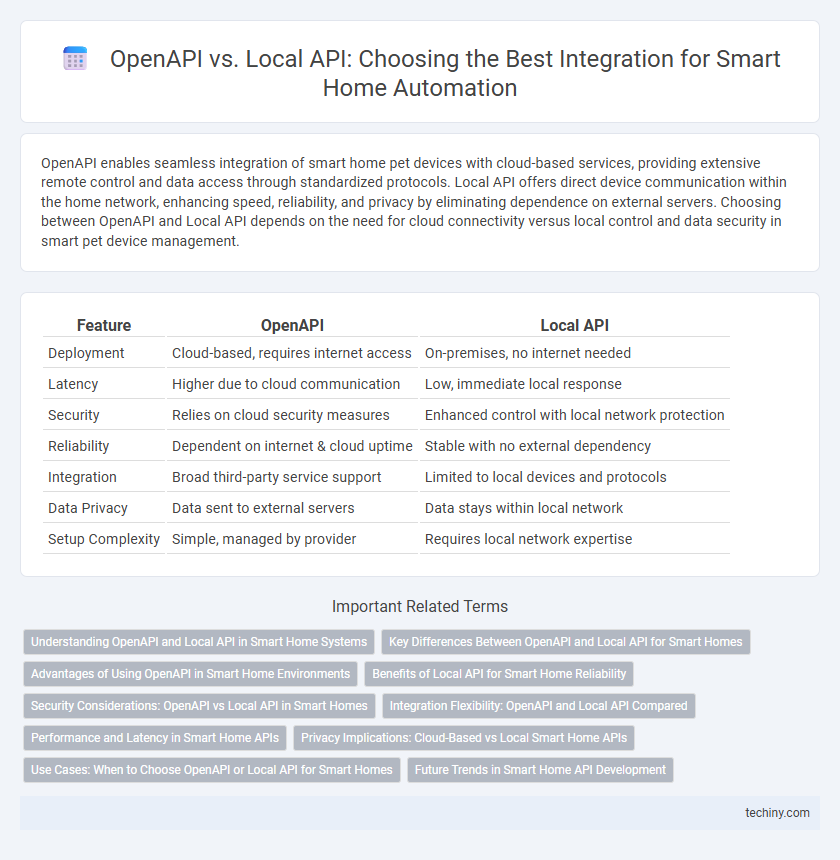OpenAPI enables seamless integration of smart home pet devices with cloud-based services, providing extensive remote control and data access through standardized protocols. Local API offers direct device communication within the home network, enhancing speed, reliability, and privacy by eliminating dependence on external servers. Choosing between OpenAPI and Local API depends on the need for cloud connectivity versus local control and data security in smart pet device management.
Table of Comparison
| Feature | OpenAPI | Local API |
|---|---|---|
| Deployment | Cloud-based, requires internet access | On-premises, no internet needed |
| Latency | Higher due to cloud communication | Low, immediate local response |
| Security | Relies on cloud security measures | Enhanced control with local network protection |
| Reliability | Dependent on internet & cloud uptime | Stable with no external dependency |
| Integration | Broad third-party service support | Limited to local devices and protocols |
| Data Privacy | Data sent to external servers | Data stays within local network |
| Setup Complexity | Simple, managed by provider | Requires local network expertise |
Understanding OpenAPI and Local API in Smart Home Systems
OpenAPI in smart home systems enables standardized communication and seamless integration across diverse devices by providing a publicly accessible specification for APIs, facilitating interoperability and remote control. Local API operates within the home network, offering faster response times and enhanced privacy by processing commands without relying on external servers, crucial for real-time automation and offline functionality. Understanding the trade-offs between OpenAPI's broad compatibility and Local API's security and performance is essential for optimizing smart home system design and user experience.
Key Differences Between OpenAPI and Local API for Smart Homes
OpenAPI enables seamless integration across diverse smart home devices through standardized web-based protocols, promoting interoperability and remote access via cloud services. Local API operates within the home network, ensuring faster response times, enhanced privacy, and offline functionality by directly communicating with devices without internet dependency. The choice between OpenAPI and Local API impacts security, latency, and scalability in smart home automation systems.
Advantages of Using OpenAPI in Smart Home Environments
OpenAPI enhances smart home environments by enabling seamless integration across diverse devices and platforms through standardized, well-documented interfaces, ensuring interoperability and easier scalability. It facilitates faster development and deployment of new features as developers can leverage existing APIs and tools, promoting a more responsive and adaptable system. Access to cloud-based resources and real-time updates through OpenAPI improves device connectivity and user experiences, offering centralized control and remote management.
Benefits of Local API for Smart Home Reliability
Local APIs enhance smart home reliability by enabling direct device communication without relying on internet connectivity, reducing latency and potential points of failure. This ensures continuous operation of critical functions like lighting, security, and climate control during network outages. Local APIs also improve data privacy and security by keeping sensitive information within the home network, minimizing exposure to external threats.
Security Considerations: OpenAPI vs Local API in Smart Homes
Local APIs in smart homes provide enhanced security by limiting data transmission within the internal network, reducing exposure to external threats compared to OpenAPIs that rely on cloud connectivity. OpenAPIs often require encrypted communication protocols like TLS and robust authentication methods to mitigate risks such as data interception and unauthorized access. Prioritizing Local API implementations can minimize vulnerabilities related to remote exploitation, ensuring greater control over sensitive smart home data and device operations.
Integration Flexibility: OpenAPI and Local API Compared
OpenAPI enables seamless integration across diverse smart home devices and third-party services, offering extensive interoperability through standardized RESTful interfaces and widespread community support. Local APIs provide enhanced security and faster response times by operating within the home network, but their compatibility is often limited to specific manufacturer ecosystems. Choosing between OpenAPI and Local API depends on the balance between broad device integration capabilities and the need for low-latency, private communication within the smart home environment.
Performance and Latency in Smart Home APIs
OpenAPI relies on cloud servers, which can introduce higher latency and reduced performance due to network dependency, especially in critical smart home applications requiring real-time responsiveness. Local APIs operate directly within the home network, minimizing latency and enhancing performance by eliminating round-trip communication to external servers. For latency-sensitive smart home systems, such as lighting control and security monitoring, local APIs offer significant advantages in speed and reliability.
Privacy Implications: Cloud-Based vs Local Smart Home APIs
Cloud-based OpenAPIs for smart homes transmit data over the internet, exposing user information to potential third-party access and increasing privacy risks. Local APIs process data within the home network, minimizing external exposure and offering stronger privacy controls through direct device-to-device communication. Choosing local APIs enhances data security by reducing reliance on cloud services and limiting data sharing beyond the household environment.
Use Cases: When to Choose OpenAPI or Local API for Smart Homes
OpenAPI is ideal for smart home systems requiring seamless integration with cloud services, remote control, and data synchronization across multiple devices and platforms. Local API is preferred for scenarios demanding low latency, enhanced privacy, and reliable operation without internet dependency, such as security systems or critical home automation tasks. Choosing between OpenAPI and Local API depends on whether the priority is global accessibility and feature-rich remote functionality or robust, private, and fault-tolerant local control.
Future Trends in Smart Home API Development
Future trends in smart home API development emphasize seamless integration and enhanced security between OpenAPI and Local API systems. OpenAPI frameworks offer scalable cloud connectivity, while Local APIs prioritize real-time responsiveness and data privacy by processing commands within the home network. Advancements in AI-driven automation and edge computing will increasingly blend these approaches, enabling smarter, faster, and more secure smart home environments.
OpenAPI vs Local API Infographic

 techiny.com
techiny.com